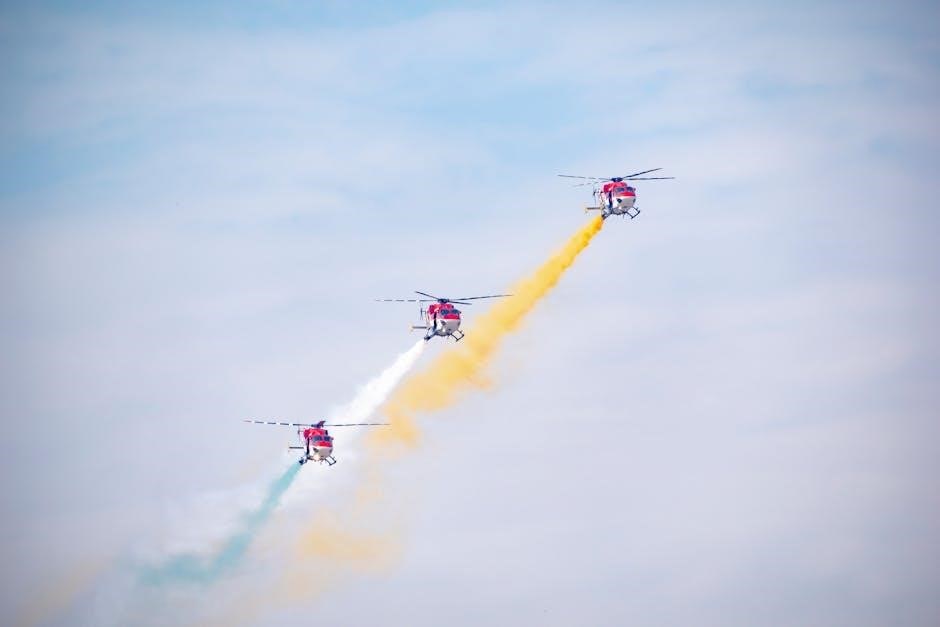Visual aircraft recognition involves identifying planes using
techniques
and
characteristics
to aid in
military operations
and
aircraft maintenance
with resources like
PDF manuals
and
online research
and articles.
Definition and Importance
Visual aircraft recognition is defined as the ability to identify aircraft by visual means, using characteristics such as shape, size, and markings. This skill is crucial in various fields, including military operations, aircraft maintenance, and aviation security; The importance of visual aircraft recognition lies in its ability to enhance situational awareness, improve decision-making, and reduce the risk of misidentification. According to recent studies, advanced tools and techniques are being developed to aid in visual aircraft recognition, including the use of deep learning algorithms and computer vision. These tools have the potential to improve the accuracy and efficiency of visual aircraft recognition, making it an essential skill in the aviation industry. By understanding the definition and importance of visual aircraft recognition, individuals can better appreciate the need for effective identification and classification of aircraft, and the role it plays in ensuring safe and secure aviation operations. This is particularly relevant in 2024, with the increasing use of PDF manuals and online research to support visual aircraft recognition training and operations.
History and Development

The history of visual aircraft recognition dates back to the early days of aviation, when identifying enemy aircraft was crucial for military operations. Over the years, various techniques and methods have been developed to aid in visual aircraft recognition, including the use of silhouettes, profiles, and identification manuals. The development of visual aircraft recognition has been influenced by advances in technology, including the use of photography, videography, and computer-aided design. In recent years, the use of digital media, such as PDF manuals and online resources, has become increasingly popular for visual aircraft recognition training and operations. The evolution of visual aircraft recognition has also been shaped by the introduction of new aircraft designs, materials, and technologies, requiring continuous updates and revisions to identification methods and materials. As a result, visual aircraft recognition has become a complex and multidisciplinary field, requiring a combination of technical knowledge, observational skills, and analytical abilities. This complexity is reflected in the variety of resources available, including 2024 PDF manuals and online research articles.

Visual Aircraft Recognition Techniques
Techniques involve
observation
and
analysis
of aircraft
characteristics
using various
methods
and
tools
for accurate identification.
WEFT Technique
The WEFT technique is a method used for visual aircraft recognition, which involves analyzing the shape and characteristics of an aircraft’s wings, engine, fuselage, and tail. This technique is useful for identifying aircraft quickly and accurately.
According to research, the WEFT technique is an effective way to recognize aircraft, and it has been used in various military and civilian applications.
Researchers have also developed automated systems that use the WEFT technique to identify aircraft, using computer vision and machine learning algorithms to analyze images and videos of aircraft.
These systems have shown promising results, with high accuracy rates in identifying aircraft using the WEFT technique.
Overall, the WEFT technique is an important tool for visual aircraft recognition, and its automation has the potential to improve the efficiency and accuracy of aircraft identification.
Further research is needed to fully develop and deploy automated WEFT systems, but the current results are promising.
VATR System
The VATR system is a visual aircraft recognition technology that uses automated systems to identify aircraft.
This system is designed to aid in the quick and accurate identification of aircraft, using computer vision and machine learning algorithms to analyze images and videos.
According to research, the VATR system has shown promising results, with high accuracy rates in identifying aircraft.
The system is able to analyze various characteristics of an aircraft, including its shape, size, and markings, to determine its type and identity.
The VATR system has the potential to be used in a variety of applications, including military and civilian aviation.
Researchers are continuing to develop and improve the VATR system, with the goal of creating a highly accurate and reliable system for visual aircraft recognition.
The VATR system is an important tool for advancing the field of visual aircraft recognition, and its development is expected to have a significant impact on the industry.
Further research and testing are needed to fully realize the potential of the VATR system.

Applications of Visual Aircraft Recognition
Visual aircraft recognition is used in
aircraft maintenance
and
military operations
with
PDF manuals
and
online resources
available for training and reference purposes always.
Aircraft Maintenance and Inspection
Visual aircraft recognition plays a crucial role in aircraft maintenance and inspection, as it enables technicians to identify potential issues and perform necessary repairs.
According to research, advanced tools are being used for smart aircraft maintenance, including visual recognition of mechanical parts.
This approach allows for more efficient and effective maintenance, reducing downtime and improving overall safety.
Online resources, such as PDF manuals and research articles, provide valuable information and guidance for technicians and inspectors.
These resources cover various aspects of visual aircraft recognition, including techniques for identifying different aircraft types and models.
By leveraging these resources and techniques, maintenance teams can ensure that aircraft are airworthy and compliant with regulatory requirements.
Effective visual aircraft recognition is essential for preventing accidents and ensuring the safe operation of aircraft.
As the aviation industry continues to evolve, the importance of visual aircraft recognition in maintenance and inspection will only continue to grow.
Therefore, it is essential to stay up-to-date with the latest developments and best practices in this field.
Air-Land Battle and Military Operations
Visual aircraft recognition is a critical component of air-land battle and military operations, enabling soldiers to identify friendly and enemy aircraft.
Military personnel use visual recognition techniques to quickly and accurately identify aircraft, making informed decisions in high-pressure situations.
According to a subcourse on visual aircraft recognition, soldiers learn to visually identify threat and friendly aircraft to function effectively in an air-land battle.
This training covers tasks related to identifying aircraft visually, including recognition of different aircraft types and models.
Online resources, such as PDF manuals and research articles, provide valuable information and guidance for military personnel.
These resources cover various aspects of visual aircraft recognition, including techniques for identifying aircraft in different environments and conditions;
Effective visual aircraft recognition is essential for successful military operations, as it enables soldiers to respond quickly and effectively to changing situations.
By leveraging these techniques and resources, military personnel can improve their ability to identify aircraft and make informed decisions in air-land battles.
Visual aircraft recognition remains a vital skill for military personnel, and its importance will continue to grow in future military operations.

Resources and References
Find visual aircraft recognition resources on
ResearchGate
and
PDF manuals
online for research.
TC 3-01.80 Visual Aircraft Recognition Manual
The TC 3-01.80 Visual Aircraft Recognition Manual is a comprehensive guide for identifying aircraft, available on Amazon and other online platforms. This manual provides enlarged diagrams and tables to aid in visual recognition. The document is published by the Headquarters Department of the Army and is a valuable resource for military personnel and aircraft enthusiasts. The manual covers various aspects of visual aircraft recognition, including the identification of friendly and enemy aircraft. It is an essential tool for anyone involved in air-land battle and military operations. The manual is available in PDF format, making it easily accessible for download and reference. With its detailed diagrams and tables, the TC 3-01.80 Visual Aircraft Recognition Manual is an indispensable resource for visual aircraft recognition training and operations, and can be used in conjunction with other resources such as ResearchGate and online research articles.
ResearchGate and Academic Publications
ResearchGate is a valuable platform for accessing academic publications related to visual aircraft recognition. Many researchers and authors share their papers and articles on this platform, providing a wealth of information on the topic. Users can find and cite research papers, such as those on the use of deep learning for aircraft identification and recognition. The platform also allows users to connect with experts in the field and stay updated on the latest developments. Academic publications on ResearchGate cover a range of topics, from the automation of visual aircraft recognition techniques to the application of machine learning algorithms for aircraft identification. These publications are available in PDF format, making it easy for users to download and access the information. By utilizing ResearchGate and academic publications, individuals can stay informed about the latest advancements in visual aircraft recognition and contribute to the ongoing research and development in this field, with new articles and papers being published regularly.


